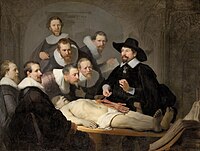
Photo from wikipedia
Aim The aim of this implementation study was to assess the effect of postmortem CT (PMCT) and postmortem sampling (PMS) on (traditional) autopsy and postmortem examination rates. Additionally, the feasibility… Click to show full abstract
Aim The aim of this implementation study was to assess the effect of postmortem CT (PMCT) and postmortem sampling (PMS) on (traditional) autopsy and postmortem examination rates. Additionally, the feasibility of PMCT and PMS in daily practice was assessed. Methods For a period of 23 months, PMCT and PMS were used as additional modalities to the autopsy at the Department of Internal Medicine. The next of kin provided consent for 123 postmortem examinations. Autopsy rates were derived from the Dutch Pathology Registry, and postmortem examination rates were calculated for the period before, during and after the study period, and the exclusion rate, table time, time interval to informing the referring clinicians with results and the time interval to the Multidisciplinary Mortality Review Board (MMRB) meeting were objectified to assess the feasibility. Results The postmortem examination rate increased (from 18.8% to 32.5%, p<0.001) without a decline in the autopsy rate. The autopsy rate did not change substantially after implementation (0.2% decrease). The exclusion rate was 2%, the table time was 23 min, and a median time interval of 4.1 hours between PMCT and discussing its results with the referring clinicians was observed. Additionally, more than 80% of the MMRB meetings were held within 8 weeks after the death of the patient. Conclusions Our study shows that the implementation of a multidisciplinary postmortem examination is feasible in daily practice and does not adversely affect the autopsy rate, while increasing the postmortem examination rate.
Journal Title: Journal of Clinical Pathology
Year Published: 2020
Link to full text (if available)
Share on Social Media: Sign Up to like & get
recommendations!